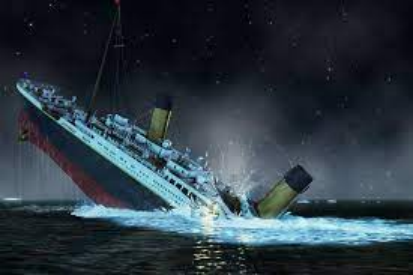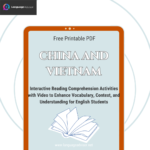Titanic:The story lives on. Interactive Reading Comprehension Activities with Video to Enhance Vocabulary, Context, and Understanding for English Students. Free Printable PDF
Titanic:The story lives on

Improving reading comprehension is a vital skill for English learners at all levels. It goes beyond just understanding the words on the page, but also involves grasping meaning, context, and intent behind a text. One effective way to enhance reading comprehension is by integrating videos alongside written exercises. Video content can provide visual cues, context, and engagement that help reinforce the learning process. In this blog post, we’ll explore a fun and interactive reading comprehension activity that combines written passages with video resources to deepen understanding and make learning more enjoyable.

Titanic:The story lives on

In 1912, the largest and most luxurious ship in the world set sail on its maiden voyage, from England to America.
When it left port on April 10th -with over 2 200 people on board- the Titanic was believed to be unsinkable, but on April 15th the ship sank in the Atlantic ocean after hitting an iceberg.
Because there were not enough lifeboats for everyone, around 1 500 people -rich and poor alike- perished in the wreck.
The story of the titanic shocked the world when the great ship sank. After the sinking, many people wanted to find the ship, and some even wanted to raise it, but this was difficult if not impossible, with the technology at the time.
In the late 1970s and early 1980s, several serious expeditions tried to locate the ship using sonar. Crew members scanned large areas of the seafloor. None of these efforts were successful.
US navy researcher Robert Ballard was fascinated by the Titanic story. Even after a failed effort to locate the ship in 1977, he didn’t give up. In the summer of 1985, Ballard worked with a French team.
After scanning the sea floor with high resolution sonar for five weeks, the search had turned up nothing.
Ballard continued the search using a new deep-sea camera device instead. For nine more days crew members saw nothing but the sea floor on the research vessel screens. But just after midnight on September 1st, they began to see unusual objects on the sea floor. Sure enough, the objects were debris from the titanic. Soon, researchers saw images of the shipwreck itself; the Titanic had been found!
News of Ballard’s discovery traveled around the world people were eager to learn more about what happened to the ship in 1912. Some survivors had said that the unsinkable ship had broken apart, but most people assumed that the ship sank in one piece. This mystery was finally solved; the ship was found in two pieces.
The following summer, Ballard returned to the wreck. This time he went down 3.8 kilometers in a deep sea submarine to see the wreck in person. The ship was rusted, but well-preserved.
Some objects inside the ship remained where their owners had left them.
Ballard explored the ship’s bow and stern sections, as well as the debris field between them.
He was careful not to disturb anything. Since so many people had died in the disaster, he thought it would be disrespectful to take objects from the site.
After Ballard’s discovery, many others explored the wreck. Not only did these scientists learn more about the ship, they also made surprising discoveries about the ocean. New species of bacteria were discovered in the rust on the ship.
Scientists had expected the ocean floor to be a barren desert. Instead, they saw that it was home to a variety of life.
Controversially, a French expedition recovered over 1,800 objects from the wreck in 1987. Ballard immediately spoke out about this, believing the wreck to be a grave site.
The remaining survivors agreed with him, but not everyone did.
Future expeditions would recover even more objects, many of these objects were quite ordinary; plates, forks, cups, glasses, decorations, and passengers’ belongings. Other objects have been more surprising; paper and clothing survived for decades on the ocean floor, bottles of wine, jars of olives and vials of perfume, still seemed as good as new. Clocks and watches still showed times around 2:20 AM -the time the ship sank.
The ship’s artifacts have been displayed in exhibitions around the world. Supporters of recovering artifacts argue that recovering and preserving the objects helps preserve history. This may no longer be a debate for the Titanic’s contents. Scientists have learned that the wreck itself is rapidly deteriorating. Luckily, the sad story of the Titanic is far from being lost; countless books, movies, new discoveries, and exhibitions, continue to tell the story of the famous ship’s first and only voyage.
Questions:
What was the Titanic initially believed to be?
a) The fastest ship in the world
b) The largest and most luxurious ship
c) The safest ship ever built
d) An unsinkable ship
How many people were on board the Titanic when it sank?
a) 1,500
b) 2,200
c) 3,500
d) 1,000
What method did Robert Ballard initially use to search for the Titanic?
a) A deep-sea submarine
b) Sonar technology
c) A surface ship
d) A helicopter
When was the Titanic discovered?
a) April 10, 1912
b) September 1, 1985
c) June 15, 1986
d) July 4, 1977
What did Ballard do to respect the site of the Titanic wreck?
a) He took artifacts from the site
b) He disturbed the wreck to investigate
c) He left objects undisturbed
d) He built a museum around the wreck
What controversial action was taken by a French expedition in 1987?
a) They took no objects from the wreck
b) They recovered over 1,800 artifacts
c) They raised the ship to the surface
d) They stopped further explorations

Watch the video

Using video in reading comprehension activities not only enhances students’ engagement but also aids in building critical language skills such as listening, vocabulary development, and contextual understanding. By incorporating multimedia into traditional reading lessons, teachers can cater to various learning styles and keep students motivated. We encourage you to try out this method and observe how it transforms reading into a more dynamic, interactive experience for your English learners.

DOWNLOAD THE PDF FOR FREE





